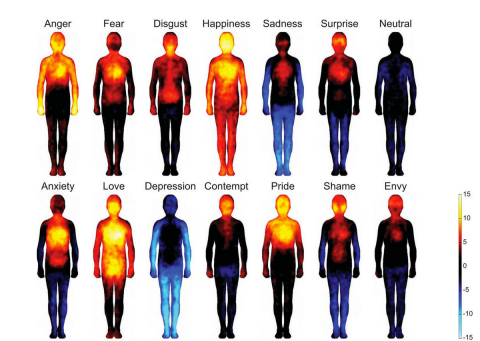“Bodily Map of Emotions” – Research paper (Nummenmaa, Glerean, Hari, Hietanen)
January 27, 2014 § 4 Comments
A team of Finnish researchers Nummenmaa, Glerean, Hari, Hietanen recently published a paper “Bodily Map of Emotions”. It outlines how people describe their emotion related body sensations. This blog post responds to the work in the context of it’s own research ‘Emotionally}Vague‘, (video presentation here).Method
Participants were emotionally primed by exposure to stimulae such as words, a short story, movies and facial expressions. They were then presented with two blank body silhouettes and asked to colour the body regions where they felt increasing and decreasing activity while viewing each stimulus. Finally, they were asked the question the other way around: viewing the the resultant body maps (such as the image above) could they recognise the emotions? This last question is interesting but the results of this section aren’t clear in the paper. The sample was both european and asian, as a basis to compare cultural experiences of emotions.

“The emBODY tool. Participants colored the initially blank body regions (A) whose activity they felt increasing (left body) and decreasing (right body) during emotions. Subjectwise activation– deactivation data (B) were stored as integers, with the whole body being represented by 50,364 data-points. Activation and deactivation maps were subsequently combined (C) for statistical analysis”
To describe the body sensation, participants painted with a 12 pixel brush and it was possible to overlay opacities, in effect, showing a range of intensities. This allows for much greater amounts of information per participant and seems nicely intuitive. The researchers then stripped out drawings that were “mean +2.5SDs of bodies untouched” (not much drawn, my guess). Word scribbles and symbols were also omitted as well as anything outside the body. (The results for the drawings outside the body would be interesting to view, in comparison to the “outside the lines” results of Emotionally}Vague, here)
Basic emotions were anger, fear, disgust, happiness sadness, surprise and the non-basic: anxiety, love, depression, contempt, pride, shame, envy as well as a neutral state. The results are displayed with positive to negative values using colour heat maps, by a combination of the two body drawings. The choice of colours for the scale seems along standard lines but it would be interesting to view it against results of emotion colour associations. (Open question – how could intensity be shown without use of colour? – 3D contour sculpture?)

“The body maps show regions whose activation increased (warm colors) or decreased (cool colors) when feeling each emotion. (P < 0.05 FDR corrected; t > 1.94). The colorbar indicates the t-statistic range.”
The results
On a very basic level of summary: culturally universal sensation patterns emerge from the research.
“it is thus possible that our findings reflect a purely conceptual association between semantic knowledge of language-based stereotypes associating emotions with bodily sensations …”
but they don’t think so, for four reasons and suggest that it’s more likely to be universal and beyond culture.

“Hierarchical structure of the similarity between bodily topographies associated with emotion words in experiment 1 (Upper) and basic emotions across experiments with word (W), story (S), movie (M)”
It’s been fascinating to examine the body maps of each emotion, both basic and non-basic. The burning cheeks of shame (compared to Spider man elsewhere online!). Pride seems similar to anger. Depression is in the arms and legs. It’s so useful to see a range of values from negative to positive representing the lack-of to presence-of emotion.
Download the paper from pnas.org here.
When it was published on December 30, a few people forwarded the link and remarked how similar it seemed to the Emotionally}Vague project. Maybe the line in the abstract “a unique topographical self-report method” was prompting them to share!
Personally it has been useful to read this paper, as it contains the specific language use for this area of study, bibliography and statistical methods outlined. It also compares very closely to the 7-year-old results of Emotionally}Vague, so on a broader level it validates and encourages the research work of artist/designers everywhere.

When art/design and science ask the same question, the results can look similar and yet very different. Here is a comparison of Emotionally}Vague, a graphic design research project and “Bodily Map of Emotions” a collaborative academic piece of research.
What do you think of the results? It would also be great to hear your thoughts around different approaches to research.

[…] This Finnish research project about the body and self-reported emotions was the main interest in January. See my review here. […]
LikeLiked by 1 person
I like how you make the point that this new research ‘validates and encourages the research work of artist/designers everywhere’. It is an excellent example of how designers and artists are often the ones who bring forth new ideas that are later validated by the social sciences and sometimes, eventually even the physical sciences.
LikeLike
Thanks Dr. Boenhert! We’re all connected in so many different ways and everything done matters, even if not apparent at the time.
LikeLike
[…] very similar research paper was published a couple of years ago by Nummenmaa et al. They had pipped us to the post but it […]
LikeLike